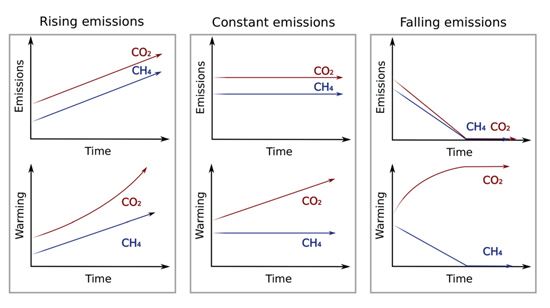| Short term Climate Pollutants
New Methane Emissions Metric Proposed for Climate Change Policy 
Oxford Martin School | June 4, 2018
A new paper published today has outlined a better way to think about how methane and other gases contribute to greenhouse gas emissions budgets. This is an important step towards evaluating the warming from methane emissions when developing strategies to achieve the goals of the Paris Agreement.
"We don't actually need to give up eating meat to stabilise global temperatures," says Professor Myles Allen who led the study (meat production is a major source of methane). "We just need to stop increasing our collective meat consumption. But we do need to give up dumping CO2 into the atmosphere. Every tonne of CO2 emitted is equivalent to a permanent increase in the methane emission rate. Climate policies could be designed to reflect this."
"Under current policies, industries that produce methane are managed as though that methane has a permanently worsening effect on the climate," says Professor Frame. "But this is not the case. Implementing a policy that better reflects the actual impact of different pollutants on global temperatures would give agriculture a fair and reasonable way to manage their emissions and reduce their impact on the environment."
A New Way To Assess 'Global Warming Potential' of Short–lived Pollutants
 Dr. Michelle Cain, Carbon Brief | June 7, 2018 Dr. Michelle Cain, Carbon Brief | June 7, 2018
Dr Michelle Cain in a science and policy research associate on the Oxford Martin School's programme on climate pollutants at the University of Oxford. "In a new paper published in npj Climate and Atmospheric Science, my co–authors and I address one of the stocktake's key stumbling blocks – the treatment of all greenhouse gases as "CO2–equivalent", using a metric known as "global warming potential" (GWP). This misrepresents the impact of short–lived climate pollutants, such as methane, on future warming.
We show that modifying the use of GWP, so that it accounts for the differences between short– and long–lived gases, can better link emissions to warming. This means that the true impact of an emission pathway on global temperature can be easily assessed. For countries with high methane emissions – due to, say, agriculture – this can make a huge difference to how their progress in emission reductions is judged."
Why Methane Should Be Treated Differently Compared to Long–lived Greenhouse Gases
David Frame and Adrian Henry Macey, The Conversation | June 12, 2018
In climate policy, we routinely encounter the idea of "CO–equivalence" between different sorts of gases, and many people treat it as accepted and unproblematic. Yet researchers have debated for decades about the adequacy of this approach. To summarise a long train of scientific papers and opinion pieces, there is no perfect or universal way to compare the effects of greenhouse gases with very different lifetimes.
This point was made in the first major climate report produced by the Intergovernmental Panel on Climate Change (IPCC) way back in 1990. Those early discussions were loaded with caveats: global warming potentials (GWP), which underpin the traditional practice of CO–equivalence, were introduced as "a simple approach … to illustrate the difficulties inherent in the concept".
The problem with developing a concept is that people might use it. Worse, they might use it and ignore all the caveats that attended its development. This is, more or less, what happened with GWPs as used to create CO₂–equivalence. The science caveats were there, and suggestions for alternatives or improvements have continued to appear in the literature. But policymakers needed something (or thought they did), and the international climate negotiations community grasped the first option that became available, although this has not been without challenges from some countries.
And on a related but different point, here is Alan Lauder's latest blog post in which he emphasises the importance of Carbon Flows in defining sustainable beef. In case you have not followed his blog, you can find a full list of posts here or here. Alan is one of the authors of the 2013 paper I quoted above in my introduction.
Opinion: "Sustainable Beef" Can't Be Defined Without Discussing Carbon Flows
Alan Lauder, BEEF Central | June 22, 2018
For the past 12 months Alan Lauder, former grazier and author of the book "Carbon Grazing – The Missing Link", has written a series of weekly blogs the Soils for Life website, discussing carbon flows in a different way for graziers to look at the landscape and understand how it functions. Published here is the final blog post in his series which ties together his years of research on carbon flows and why they are central to the sustainable beef debate.
The most over–used and misused word in the English language is "sustainable". Everybody uses it, but often there is little agreement on what it means. The term is like a magnet to nebulous feel good words.
Beef production being sustainable has two aspects, producers have to remain profitable and the environment has to remain healthy as a result of beef production, including water quality.
To achieve both aspects of sustainability, the "resilience" of the paddock has to be maintained. The only way paddock resilience can be maintained in both the short–term and long–term, is to ensure that sufficient carbon keeps flowing through the paddock. The natural world can't "function" without carbon flows.
| |
